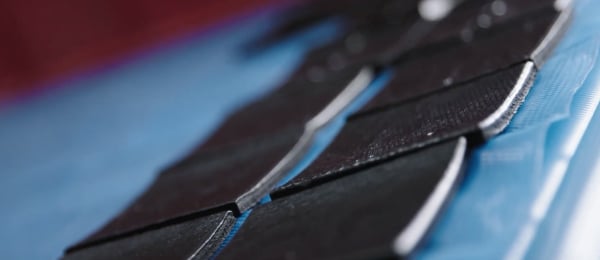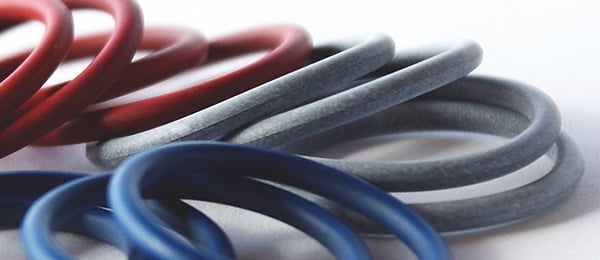
Elastomer materials
(NBR) Acrylonitrile Butadiene Rubber
Main features:
- good mechanical strength properties
- very good oil resistance
- good abrasion resistance
- low ageing and weathering resistance
- moderate compression set
Hardness range:
- 30 to 90 Shore A
Chemical resistance:
- good resistance to mineral oils and fuels, vegetable and animal oils, silicon oils, water, dilute acids and bases at room temperature
- insufficient resistance to solvents and flame-retardant hydraulic fluids
Temperature resistance:
- -30°C to +100°C (+120°C)
Additional references:
- the properties of NBR vulkanizates are mainly contingent upon the acrylic nitrile content (ACN) and show good mechanical properties.
- the resistance to oils and fuels improve with higher ACN content compounds, whereby the to the same extent the low-temperature flexability and compression set decrease.
- NBR-LT "low-temperature" feature a temperature resistance of -60°C to +80°C (+100°C) - Special materials upon request.
(HNBR) Hydrogenated Nitrile Butadiene Rubber
Main features:
- very good mechanical properties
- very good oil resistance
- very good abrasion resistance
- very good hot air resistance
- very good ozone and weathering resistance
- good low-temperature flexibility
- low compression set
Hardness range:
- 35 to 90 Shore A
Chemical resistance:
- good resistance to mineral oils, flame-retardant hydraulic fluids, hot water, steam, dilute acids and bases
- insufficient resistance to aromatic and polar solvents as well as concentrated acids and bases
Temperature resistance:
- -30°C to +150°C (+175°C)
Additional references:
the properties of HNBR vulcanizates are mainly contingent upon the acrylic nitrile content (ACN) and show good thermal and mechanical properties.
- HNBR-LT "low-temperature" feature a temperature resistance of -50°C to +150°C - Special materials upon request.
(EPDM) Ethylene Propylene Diene Rubber
Main features:
- good elastic characteristics
- very good weathering resistance
- good ageing, cold and hot temperature resistance
- good chemical resistance
- low compression set
- good hot water and steam resistance
Hardness range:
- 40 to 90 Shore A
Chemical resistance:
- good resistance to hot water and steam, glycol based brake fluids, many acids and bases, polar solvents
- insufficient resistance to mineral oils and solvents
Temperature resistance:
- -40°C to +130°C
Additional references:
Due to the good resistance and the many potable water approvals, EPDM is the preferably used elastomer in water applications. Peroxide crosslinking compounds are typically used for water applications.
- EPDM-perox: temperature range: -50°C to +140°C (+160°C) - Special materials upon request.
(FKM) Fluoro Rubber
Main features:
- moderate tensile strength
- very good resistance to ozone, oxygen, ageing and weathering
- very good hot temperature and chemical resistance
- low gas permeability, good use for high vacuum applicaitons
- flame-retardant
- limited flexibility at low-temperatures
- low compression set resistance
Hardness range:
- 60 to 90 Shore A
Chemical resistance:
- good resistance to mineral, vegetable and animal oils, fuels, many acids, bases and solvents
- insufficient resistance to polar solvents, certain bases, superheated steam
Temperature resistance:
- -20°C to +200°C (+250°C)
Additional references:
Special materials:
- low temperature FKM-GLT: -40°C to +200°C (+220°C)
- low temperature FKM-LTFE: -50°C to +200°C
(FFKM) Perfluoro Rubber
Main features:
- very good resistance to the most chemicals, amines, ketones and esters
- limited low temperature resistance
- the basic costs of this material are quite high, therefore this elastomer is mainly used in applications where other materials fail.
Hardness range:
- 60 to 90 Shore A
Chemical resistance:
- outstanding chemical resistance similar to that of PTFE materials
- limited resistance to very hot steam (special compounds on request for this purpose)
Temperature resistance:
- -15°C to +260°C (+320°C)
(ACM) Acrylic Rubber
Main features:
- good ozone and ageing resistance
- very good mineral oil and mineral oil base grease resistance
- good transmission oil resistance (with EP additive), ATF oils
- limited low-temperature flexibility
Hardness range:
- 50 to 80 Shore A
Chemical resistance:
- low chemical resistance
- good against aliphatic hydrocarbons
Temperature resistance:
- -20°C to +150°C (+165°C)
Additional references:
ACM is frequently used in the automotive segment.
(AEM) Ethylene Acrylic Rubber
Main features:
- very good ozone and weathering resistance
- very good mineral oil and mineral oil based grease resistance
- good resistance in water and refrigerants
Hardness range:
- 50 to 80 Shore A
Chemical resistance:
- good chemical resistance in general
- good against aliphatic hydrocarbons
Temperature resistance:
- -30°C to +150°C (+175°C)
Additional references:
AEM is frequently used in the automotive segment.
(VMQ) Vinyl Methyl Rubber (Silicone)
Main features:
- outstanding heat and hot air resistance, top low-temperature flexability
- very good ozone, ageing and weathering resistance, very good dielectric properties
- very good physiological properties, anti-adhesive surface properities
- good elastic behaviuor
- high gas permeability
Hardness range:
- 30 to 80 Shore A
Chemical resistance:
- good against synthetic and vegetable oils, glycols, flame-retardant hydraulic fluids, certain solvents, water up to +100°C
- poor resistance against mineral oils, solvents, acids, bases, steam and silicon oils
Temperature resistance:
- -60°C to +200°C
Additional references:
Silicon rubbers distinguish themselves through their high thermal resistance, good low-temperature flexibility, good electrical properties and very good resistance against oxygen and ozone.
Special material - FVMQ - Fluorosilicon:
Fluorosilicon rubber (FVMQ) has in addition to the typical properties of silicon (VMQ), a significant resistance against oils, fuels and solvents. This is particulary for aromatic and chlorinated hydrocarbons and alcohols. Due to the high temperature range of -60°C to +200°C and the excellent chemical resistance, also against aggressive media, FVMQ gives a numerous application options.
Temperature resistance of FVMQ:
- -60°C to +200°C
(CR) Chloroprene Rubber
Main features:
- excellent ozone and weathering resistance
- good refrigerating agent, ammonia
- good low-temperarture flexibility
Hardness range:
- 40 to 80 Shore A
Chemical resistance:
- good silicon oil and silicon based grease resistance
- limited mineral oil resistance (free of aromatics)
Temperature resistance:
- -35°C to +100°C
Additionol references:
CR is used in particular with many types of refrigerating agents like frigene/freon. CR exhibits a very good ozone and weathering resistance.
(SBR) Styrene Butadiene Rubber
Main features:
- has good mechanical properties i.e. abrasion resistance, low compression set, rebound, tensile strength and elongation.
Hardness range:
- 30 to 90 Shore A
Chemical resistance:
- very good alcohol and glycol resistance
- good silicon oil and silicon oil based grease resistance
- no resistance against fuels, benzene, mineral oils and mineral oil based grease
Temperature resistance:
- -30°C to +70°C
Additional references:
SBR is used in particular for the production of tires, conveyor belts, brake pads and clutch linings, due to its good mechanical properties.

